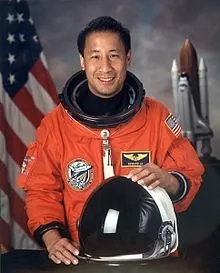
Ed Lu Ph.D. 89 is a former NASA astronaut more recently known for his work as CEO of the B612 Foundation, which aims to “hunt asteroids that could hit the Earth and potentially cause human devastation.” Lu sat down with The Daily to discuss his time at Stanford, his passion for space and why he considers asteroids to be one of Earth’s biggest threats.
The Stanford Daily (TSD): What made you start thinking about NASA and being an astronaut?
Ed Lu (EL): I did not think about becoming an astronaut until long after I’d left graduate school and left Stanford. I just sent in an application and was accepted in 1995. A friend of mine told me you could apply, so I sent in an application myself.
TSD: Were you expecting to be accepted? When you did get your “acceptance letter,” so to speak, and what was your reaction?
EL: Oh, absolutely not! It was a total surprise! It was kind of shocking. I realized my life was going to change from that point. So yeah, it was definitely … definitely a seminal moment in my life.
TSD: Tell me more about your time at Stanford. Did your Stanford experience help you or influence your time at NASA?
EL: Oh, it was crucial. I got my Ph.D. there — was there from 1984 to 1989, studying astrophysics and working under my advisement professor Vahe Petrosian, who’s still there. You know, this is where I really learned astrophysics. This is where I learned to be a scientist.
TSD: Aside from your academics at Stanford, as a Ph.D. were you involved in any activities or extracurriculars?
EL: Well, those are all the things that you do as an undergraduate. As a graduate student, you’re mostly filling your life with p-sets. It’s just different. I did a lot of other things while I was there, but your job as a graduate student is to get your Ph.D.
I was a wrestler. I used to wrestle for Cornell back in the early ’80s. I did work out with the Stanford wrestling team on occasion, just for fun.
TSD: I’d like to ask you about your time with NASA. What was your experience like as an astronaut? How many flights, for example, did you get to go on, and what was your title?
EL: I was an astronaut — that was my title. I flew three space missions. Well, I took space shuttle Atlantis twice, in 1997 and again in 2000. Immediately following the loss of space shuttle Columbia in 2003, I was selected to fly the rescue mission to the International Space Station. So, nine weeks after that, I flew a Russian Soyuz spacecraft to the International Space Station, where I spent six months in 2003.
TSD: In all of your NASA experience, what were the most defining moments for you, or maybe your most exciting?
EL: I think that was the most defining moment of my NASA career — you know, our response after the Columbia disaster, how we kept the Space Station alive when the space shuttles were grounded and learning to fly a Russian ship with just two people, a two-man crew.
I and one other Russian guy were sent to basically keep the space station alive. It was quite a time, you know? A crisis because we’d just lost the shuttle and seven friends and we were left with this conundrum of how to keep the space station alive, and the decision was then to drop a crew of two people, and that meant having an American actually be a copilot of a Russian space ship to get there.
Anyhow, the defining moment of my career has really been since NASA with the B612 Foundation, building an outer-space telescope to try and track asteroids that can hit the Earth so we don’t see the incidents that we saw a few weeks ago or something much, much worse. What we saw a few weeks ago was tiny, absolutely tiny.
TSD: What prompted you to leave NASA in the early 2000s?
EL: It was just time to do something different. I’d been doing it for 12 years, and I was looking for new challenges. And there’s probably no bigger challenge out there — if you think about it — in the long term, than trying to save the world [with the B612 Foundation], right?
TSD: There’s so many different ways, people might think, to save the world, but you chose maybe the most challenging.
EL: Yeah, but it’s the only one I know how to do. You know there are a lot of pressing world problems, none of which I know how to solve except for this one. And in most cases, nobody knows how to solve any of the other ones, either. And it’s not that you shouldn’t try, but the one thing I know how to solve I’m going to go do.
TSD: Can you give me a brief overview of what the B612 Foundation does?
EL: First off, I’d send you to our website, which is b612foundation.org. There we explain what the problem is, why this is a risk to humanity and how we’re going to solve the problem. Basically, we build a telescope that is going to launch in 2018 which is going to find and track all the million or so asteroids that threaten Earth. It turns out that stopping asteroids is relatively easy if you know in advance that something’s coming, and so we’re going to provide that advance notice.
It’s a private effort, so our supporters are donors from around the world. We realize that nobody else is doing this and that the fastest way to get it done is to do it ourselves. So that’s what we are doing. It’s going well. We are only five years from launch at this moment.
This interview has been condensed and edited.